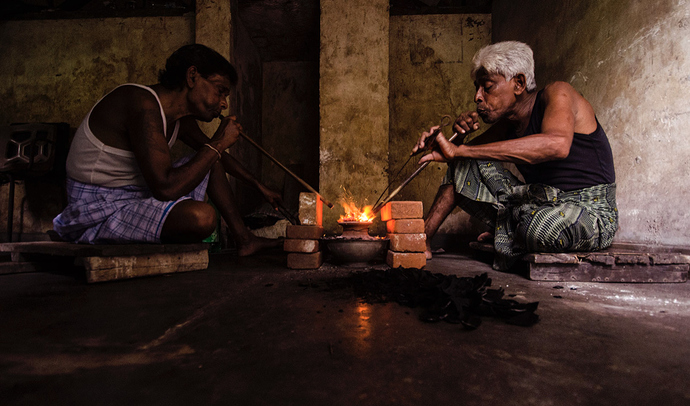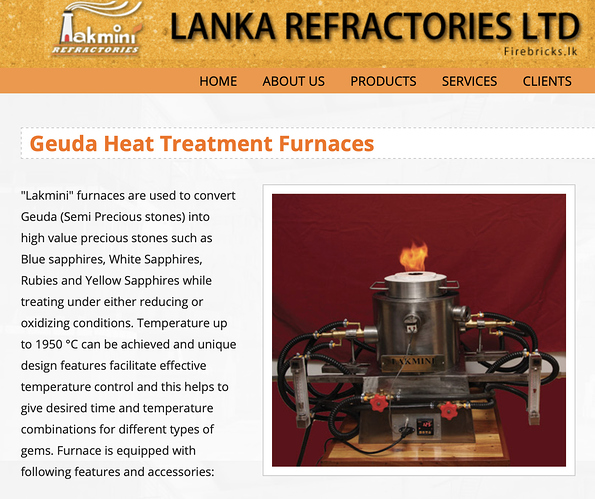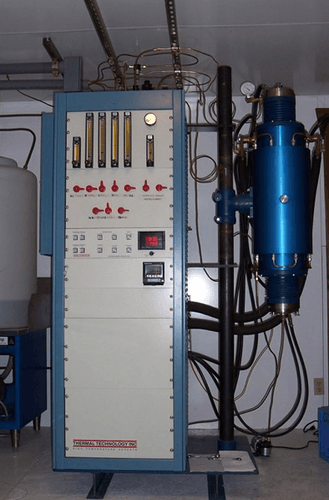I thought I’d recently read somewhere that heating sapphires was very difficult to test, especially low heat as the gem has been heated naturally when forming. I’m sure better learned colleagues will be able to advise further.
I defer to sapphire experts but won’t microscopic observation on the nature and type of silk (rutile) in the stone help in identifying heating? It was my understanding (at least in rubies) that lightly heated stones will sometimes show remnant silk (which more intense heat treatment will have completely removed)?
We had some clients who were sapphire shopping 2 months ago in SL. Being non-gemologists we were quite concerned that they might be over-charged. Indeed they were often being offered ‘unheated’ stones (with local certificates) at significant premiums. I sent them details of SL stones available from one of our London dealers for comparison while they were there and they decided to instead make a purchase when they were next in London (in April) - to their (admittedly inexperienced) eyes they were not being offered anything of better value on the ground in SL, plus there was the added cloud over how legitimate these certificates were. It sounds as though it was probably a better outcome for them, judging from what Elijah has found.
Hi Andy,
Unfortunately, the ones that i bought were internally flawless, so the lab had much difficulties as they didnt have any rutiles/inclusions to check for.
I had a chat with the dealer in Sri Lanka, he seemed genuinely surprised that Singporean labs made such he finding, and he was quite confident it was an unheated stone. He even guaranteed that if we were to send it to GRS, it would come back as unheated.
Another dealer i talked to said that low heat treatment was fairly common in Sri Lanka since about a decade ago.
Not sure if anyone well versed in this area would be able to offer their views?
Almost all (80%) of the sapphires in Sri Lanka are low heat treated. In fact, they don’t consider this as ‘Heat Treatment’. So, they are right and you are right! Low heat treatment is almost undetectable. So, a big high five to the lab that detected it. Would be interesting to know how they did it.
Real Heat Treatment is done in Thailand and not Sri Lanka.
raj rao - Gemz LLC (USA)
Hi Raj,
Have taken it to 2 labs in Singapore and both raised the issue of low heat treatment. They mainly looked at inclusions and a spectrometer to determine it, it definitely took longer than usual.
Hi, as there is a clear difference in heat treatment done in lab or naturally…in corundum silk is one thing that will prove it if it’s heated in lab…the rutile threads will turn into broken dots and other identification is the burst halos …which is any crystal (mineral) that melts while heating and solidifies…bears a Halo around… which is a clear indication of heat treatment in lab and not natural.
Some Corundum can show signs of being thermally enhanced but have not been treated by man. Corundum that is brought to the surface by magma will show the same signs of thermal enhancement as those stones that have been intentionally and typically treated for color and clarity in a lab as the temperatures they have been exposed to are similar. These geographical locations are know thus the determination of origin can contribute to the determination of the process being natural or not. For instance Burma Ruby having been formed and mined from placer deposits or hard rock we know have not been naturally exposed to the temperatures of magma this broken silk or tension halos are diagnostic. Only treatments that are done after faceting and or get close to the melting point of the Corundum can the natural process be distinguished from the lab process for Corundum from known magma produced deposits. Temperatures used on rough low enough not to affect the rough or it’s inclusions are undetectable.
DBH GIA, GG, AJP
Hey Elijah!
My name is Chris from Navneet Gems’ marketing team.
So I have discussed this question with one of our company experts and definitely he said that in Srilanka labs are always have favorism. They will write whatever the seller wants them, because they are unknown, poorly managed, labs that don’t have enough money to afford advance equipment. GRS does not have very high credibility in the world market except for in China as they are a business friendly lab. Our company don’t like GRS so much, because Navneet is a gemologist and the GRS is too business friendly and will write terms like “pigeon blood” for deep red non pigeon blood ruby stones.
As far as low heat goes, srilankans are the master of low heat and high heat (HPHT), this is a huge thing in worldwide customers now, stones are accepted, but the buyers must know. The best lab now for coloured stones is Lotus geology, owned by Billy hugges, she is the daughter of Richard Hugges. They are genuine people who are gemologists by nature and not business friendly owners. SSEF and Gubelin are other reputable labs in Switzerland that will never make a wrong call on their stone call.
If you need really specific help, you can ask my boss directly, he will help you please visit www.navneetgems.com, he also have some microscopic photos to explain low heat and high heat. But a clear understanding can be made with this image here attached.
Good luck!
Navneet
Traditional Blow Pipe Treatment - Sri Lanka
Most sapphires are heated.In the industry it’s almost a given. Try using an Emersion Cell with the proper RI oil.
Hello everybody
Best quality of Sapphire & Ruby
in Sri Lanka are absolutely NOT Heated
and that is very satisfying.
Many years there
Peter from Sweden
@lundin9, Yes very correctly said, on the better quality stones and larger sizes, absolutely no heat.
On the smaller stones there have been low temp heat treatment over the recent years . I have noticed when some stones are too clean and the color is good, some times labs are making Conservative remarks and saying Low heat. I think as much as its lab / gemologist call it all depends on the experience of the gemologist and how many stones they are seeing on a daily basis which will keep them more current with low heated goods in the market
A quick note here from GIA on treatments for some stones on color and heat treatments that appear on certain stones;
COLOR ORIGIN CANNOT CURRENTLY BE DETERMINED
Many gemstones are routinely treated by different methods to improve the color or appearance. In some cases, treatments like heating and irradiation cannot be detected.
Heat Treatment
A wide range of gem materials may be subjected to low temperature heat treatment to improve or change the color of the stone. It is also possible for this heating process to occur naturally when the gemstone is in the earth. To determine if the heating was done by man (as a treatment) vs. heating by nature may be difficult if not impossible.
Irradiation
Some gem materials may be subjected to irradiation to improve or change the color of the stone. Generally, there is no residual radioactivity left in such stones. These same gemstones may be naturally irradiated in the earth over a long period of time. To determine if the irradiation was done by man—as a treatment—or by nature is usually not possible with today’s testing methods
First photo is of treaters practicing the ancient art of blowpipe heating in Ratnapura, Sri Lanka. This practice was described by al Beruni ca. 1045 AD, and the temperatures reached by this technique exceeds that of the melting point of gold (1064°C). Photo: Wimon Manorotkul
High tech gas fired ovens are manufactured and used in Sri Lanka as well, and in the late 1980’s Sri Lankan’s began importing sophisticated electric ovens to heat treat their sapphires.
Low temp heat treatment up to about 600C has become more common in Sri Lanka over the past decade and can be very difficult to detect. Often sapphires require sophisticated FTIR spectroscopy to determine if they have been heated, or not.
I have been observing this and saying this for quite some time now, especially concerning Montana and Sri Lankan sapphires. The big labs are often just making SWAGs and operating in a safe mode to avoid liability. ;)) [A SWAG is aka a Scientific Wild Ass Guess and the Safe Mode is just stating the stone is HEATED if they are not sure or can’t tell.]
Hello everyone,
It seems like to be an old question, but there are some updates that we would like to provide in regards to heat treatment of blue sapphires. Since that is what this topic is about so the update must be done. Actually I was thinking about the new HPHT sapphire quite a bit - been researching, reading alot of information and finally I had found someone who is a specialist in material science and does alot of experiments on ceramics, heating, treatments himself. He wasn’t much in the trade but more towards the academic of side. His name is Mubashir Mansoor.
I then made a great connection with him and did a webinar and found many interesting facts about the HPHT blue sapphire. Notice how I understand that there is a confusion between HPHT / HT-P between a few labs and the industry, especially when GRS claimed that this treatment was causing the stones to be “weak”.
So we did a webinar on HPHT blue sapphires with Mubashir Mansoor - and this video is available to watch here: HPHT Sapphire Q&A With Mubashir Mansoor - YouTube
Hope this helps readers of this topic and any questions please send those over.
For Citation:
Mansoor, M., Agarwal N., Navneet Gems (2020). Heat Treatment of Blue Sapphire (The potential effects of pressure) [Video]
Regards
Navneet
Hi! Yes I totally Agree. I do think much of origin though can be seen via spectrometer and by S.G. in lieu of a nano microscope. Your thoughts? - Mike G. IGS Acquire Collectibles Certified Professional Gemologist
Hi Mike,
While identification of gem material can be made in certain stones that have similar optical characteristics and separation of synthetics vs natural stones mostly the key separation, per GIA gem identification manual, is magnification. I had one student while teaching Gemology who was like a dog with a bone and took the time to figure the specific gravity of every stone he tested. Specific Gravity is a key test in so very very few gems in the identification of the material I don’t know how it can be a separation or identification factor of source. Corundum is going to be 4.0 everywhere it is found and only when a crystal has so many other inclusions that are significantly different in S.G. can a gem material be significantly altered. In general there are primarily two manners in which gems are identified by source, which is, magnification of growth features and inclusions, such as horse tail inclusions in Demantoid garnets, rutile silk in Burma ruby and tourmaline requires the analyzing of the trace elements to separate sources. Now keep in mind even these methods have flaws and are not 100% accurate but they are the best and most accurate available methods to date for sourcing gems.
Hope this helps.,
Don Hofler GIA GG, JP
“Real” heat treatment was practiced in Sri Lanka hundreds of years before they started in Thailand. Hi-tech heat treatment with electric ovens started in Sri Lanka in the 1980’s and today, the Sri Lankan’s are the best at heating geuda from their own mines.


